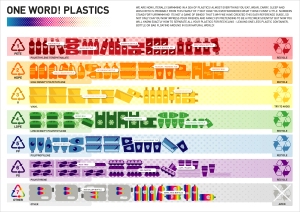Recycling uses old plastics to make new plastic products.
Plastic recycling reduces the world demand for virgin plastics and the need to consume natural materials. In this way, plastic recycling helps to conserve important raw materials and protects natural habitats for the future
Recycling plastics saves energy. The energy required to make recycled plastic is 8 times less than the energy required to make virgin plastic. For each single bottle recycled, this energy saving is equivalent to the energy needed to light a 60W bulb for up to six hours.
As recycling saves energy it also reduces greenhouse gas emissions, which helps to tackle climate change. Current UK recycling is estimated to save more than 18 million tonnes of CO2 a year – the equivalent to taking 5 million cars off the road.
Recycling plastics reduces the amount of waste going to landfill sites. In the UK, 57 million tonnes of rubbish, including industrial waste, are being disposed in landfill sites each year. Every time some one recycles a piece of plastic packaging the amount of waste going to a landfill site decreases.
UK households use an estimated 12 billion of plastic bottle every year but only 7 billion are recycled, the other 5 billion go to landfill sites. Pledge4plastics are asking people to pledge to just recycle one more plastic bottle each week – this small change can make a massive difference to the world.
How does plastic recycling work?
Plastic recycling requires several steps to turn discarded plastic into new products. The first step is sorting; the plastic must be sorted from other recyclables such as metal and cardboard, and then the plastic must be sorted into different types.

Infographic credit: Plastiki. There are 7 different types of plastic used in household packaging – not all of them are recyclable
Some recycling facilities can only process certain types of plastic and they rest will most likely be sent to a landfill site. Check your local recycling centre for information on which plastics they can recycle.
The plastic is then ground down into small chips or flakes. These small pieces of plastic are normally contaminated with impurities (e.g. from labels, or from the previous contents of the plastic container) so they must be washed clean with a special bath. The pure plastic pieces are then dried, melted, and formed into pellets.
These pellets are then sold to manufacturers to be made into recycled plastic products. They might be turned into fibres to make fleece jackets or used to make carpeting or floor tiles.
This video tells the story of how plastic bottles are recycled:
Plastic Bottles – how they are recycled from RecycleNow on Vimeo.
What plastics can be recycled?

 Plastic types 1 (PETE) and 2 (HDPE) are the most widely recyclable. These 2 categories of plastic include water bottles, pots, tubs, jerry cans, toys, and carrier bags among other items. Look out for these two symbols and where you need to buy something packaged in plastic try to limit it to recyclable plastics.
Plastic types 1 (PETE) and 2 (HDPE) are the most widely recyclable. These 2 categories of plastic include water bottles, pots, tubs, jerry cans, toys, and carrier bags among other items. Look out for these two symbols and where you need to buy something packaged in plastic try to limit it to recyclable plastics.
If you find yourself with other types of plastic that are not currently recyclable where you live why not re-use them as something fun and exciting?
How can I recycle plastics?
You can use the RecycleNow interactive recycling map to find out where your nearest recycling banks are and what you can recycle at home. Contact your local council or visit a One Stop Shop to find out more about local recycling collections.

Frustration!
Trying to save space so decided to put DVDS into a larger plastic (sorry – but was second hand) cd wallet, took all the paper sleeves out the cases and took the plastic ones to the recycling centre only to be told to put them in the general waste.
So disheartening to try and be green!
LikeLike